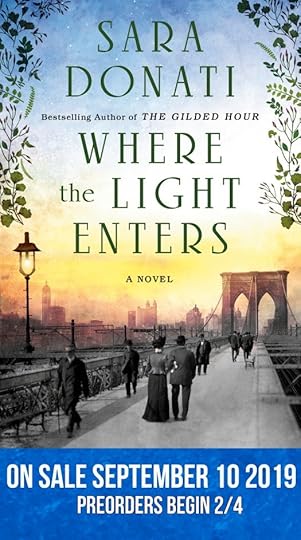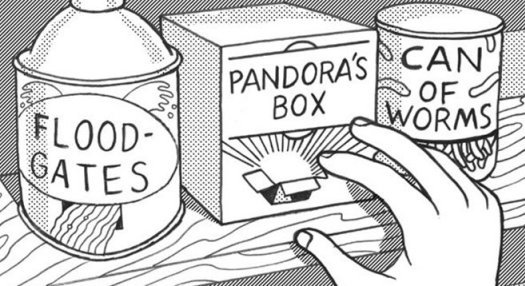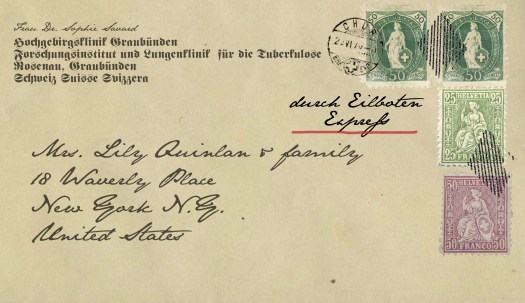Rosina Lippi's Blog, page 2
December 21, 2019
Novels I re-read and thus, recommend
 I posted a list like this once before, some years ago, and find that it is out of date. So here’s a more recent take on the type of fiction that is most likely to draw me in.
I posted a list like this once before, some years ago, and find that it is out of date. So here’s a more recent take on the type of fiction that is most likely to draw me in.
Note: I’m not claiming these are the best novels ever written. I know for a fact that some of them will raise eyebrows; the point is, I felt enough resonance with that piece of storytelling that I go back for more now and then. There are also novels I truly admire, but could not bring myself to read again. So you won’t find them here.
This list is not divided up by genre, so let me warn you: you’ll find pretty much everything here, from espionage and romance to very dark crime and sci-fi. And then there’s Austen and Dickens.
Richard Adams The Girl in a Swing
Jane Austen Persuasion; Pride and Prejudice
Toni Cade Bambara Gorilla, My Love
Amy Bloom Come to Me
James Lee Burke In the Electric Mist With Confederate Dead; White Doves at Morning; A Morning for Flamingos
A.S. Byatt Angels & Insects; Possession
Chelsea Cain Heartsick (Gretchen Lowell series)
Jetta Carleton The Moonflower Vine
Michael Chabon The Amazing Adventures of Kavalier & Clay
Loretta Chase Lord Perfect; Lord of Scoundrels
Wilkie Collins The Woman in White
Laurie Colwin A Big Storm Knocked It Over
Jennifer Crusie Crazy for You; Faking It; Welcome to Temptation
Judy Cuevas Dance; Bliss
Junot Díaz The Brief Wondrous Life of Oscar Wao
Stephen Dobyns The Burn Palace
Dorothy Dunnett Niccolo Rising (House of Niccolo; 8 volumes)
Daphne Du Maurier Rebecca
George Eliot Adam Bede
Ken Follett Eye of the Needle
Ariana Franklin City of Shadows; Mistress of the Art of Death
Charles Frazier Cold Mountain
Thomas Hardy Far from the Madding Crowd; The Mayor of Casterbridge
Mo Hayder Poppet (the Jack Caffery series)
John Fowles The French Lieutenant’s Woman
Mark Helprin A Soldier of the Great War
Judith Ivory Beast
Baine Kerr Wrongful Death
Stephen King The Stand; Black House; Dolan’s Cadillac
Barbara Kingsolver Animal Dreams; The Poisonwood Bible
Lisa Kleypas Smooth Talking Stranger; Blue-Eyed Devil
Stieg Larsson The Girl with the Dragon Tattoo (and the next two)
Margaret Lawrence Hearts and Bones (Hannah Trevor series; 4 volumes)
Harper Lee To Kill a Mockingbird
Dennis Lehane Gone, Baby Gone; Darkness Take My Hand
Elmore Leonard Pagan Babies, Cuba Libre, Get Shorty
Gabriel Garcia Márquez A Hundred Years of Solitude
McCarry, Charles: The Bride of The Wilderness
Larry McMurtry Lonesome Dove
Jacquelyn Mitchard Second Nature; The Breakdown Lane
Toni Morrison Beloved, The Bluest Eye
Jojo Moyes The Girl You Left Behind
Alice Munro Friend of my Youth
Audrey Niffenegger The Time Traveler’s Wife
Tim O’Brian The Things They Carried
Michael Ondaatje The English Patient
Joseph O’Neill Netherland
Ann Patchett The Magician’s Assistant
Susan Elizabeth Phillips Ain’t She Sweet
Annie Proulx The Shipping News; Wyoming Stories
Mario Puzo The Fortunate Pilgrim
Mary Doria Russell A Thread of Grace
Richard Russo Straight Man; Empire Falls
Karin Slaughter Will Trent series (8 volumes)
Jane Smiley A Thousand Acres
Scott Spencer Waking the Dead; Endless Love
Jessica Davis Stein Coyote Dream
Kathryn Stockett The Help
William Styron Sophie’s Choice
Barry Unsworth Sacred Hunger
Gore Vidal Burr; Lincoln
Kurt Vonnegut Slaughterhouse-Five
Edith Wharton Ethan Frome
Laura Ingalls Wilder The Long Winter

September 7, 2019
all the novels. so far.
Publication Order of Wilderness Books
Into the Wilderness
(1998)
Hardcover Paperback Kindle
Dawn on a Distant Shore
(2000)
Hardcover Paperback Kindle
Lake in the Clouds
(2002)
Hardcover Paperback Kindle
Fire Along the Sky
(2004)
Hardcover Paperback Kindle
Queen of Swords
(2006)
Hardcover Paperback Kindle
The Endless Forest
(2009)
Hardcover Paperback Kindle
Publication Order of Gilded Hour Books
The Gilded Hour
(2015)
Hardcover Paperback Kindle
Where the Light Enters
(2019)
Hardcover Paperback Kindle
Publication Order of Standalone Novels
Homestead
(1997)
Hardcover Paperback Kindle
Tied to the Tracks
(2006)
Hardcover Paperback Kindle
The Pajama Girls of Lambert Square
(2008)
Hardcover Paperback Kindle

February 1, 2019
ta-da… where the light enters
September 14, 2018
You Can Dance
Right now I’m trying to get Little Birds off the ground, and it has been a struggle. It’s always a struggle, but these characters are not at all clear yet, and until I get a better sense of them everything is stalled.
Today I had a kind of breakthrough, which doesn’t happen often. I’m writing about it here so I will remember exactly what happened, and also to entertain readers who happen to wander by.
Two of the primary characters in Little Birds are pretty well established in my head (they are Lily’s children, but you don’t know them), but a crucial third character — somebody entirely new — is missing. This has been causing me some distress. Of course I did what all writers of fiction do in this all-too-common fix: I found a way to procrastinate and went out to run errands.
Driving home from errands, I decided to turn off the audiobook that was playing (dry, but interesting) and turn on my current music playlist, which is set to shuffle. The song that started took me by surprise because I forgot it was on the list: Save the Last Dance for Me — the Drifters original recording.
And suddenly I had that third missing character. I don’t even know his name yet, but I can see him leaning against a wall, arms crossed, watching people dance. Or maybe, just maybe, somebody has offered him a fiddle and he’s playing and watching the dance floor.
Where did this come from, you might be wondering. I had to think about it to sort out the associations, but it ties into my own experiences while I was living in Vorarlberg in my early twenties. I did a lot of dancing. There were dances, all the time. Simple weekend dances. Big fancy dances for Mardi Gras or annual celebrations of one guild or another. Big or small they all featured local musicians and dancing. And lots of beer. And schnapps. You’re thinking ump-pa-pa, but no. That’s not what it’s like at all and I’m not sure I can make it clear how un-umpa this experience is, but I’m going to try.
Imagine a lot of people crowded onto the dance floor, some proportion of them much the worse for beer, still cheerful as they bumbled along. Some small portion — maybe fifteen percent — were there because they really liked dancing and were good at it. I was in that fifteen percent.
This is a video from Helsinki, a polka dancing competition. The music is scaled way way down, but I’m posting this here so you can see the dancing. You can hear the excitement in the audience, and hear them yodeling in appreciation. This captures part of what it’s like.
In your imagination you have to speed this up some, and also imagine it is happening in a hazy smoky dance hall (ca 1980), and now imagine the dancers are just regular (and somewhat younger) in their nice-casual clothes. But they can dance. Speed it up again. If you’re good at this there’s a lot of improvising, double and triple steps, stamping, things I can’t really describe but I could do, and do well. If I had stayed there I’d probably weigh 120 and be able to carry a calf around, no problem. It’s exercise and cardio exercise all rolled into a single package that you WANT. And that’s the trick, of course.
One of the chapters in Homestead was meant to capture what this kind of dance was like. Now, today, while I was listening to Save the Last Dance I had a flashback to the dance I described in that chapter. This is what happened in real life: Someone I didn’t know asked me to dance toward the end of the evening, when the musicians had had a couple shots of schnapps and they were just on a tear. I had noticed this guy dancing and hoped he might come ask me, because watching him I knew that I would dance well with him.
 Here’s the thing, in this kind of dancing. If a guy who is strong and lithe and confident puts a hand on your waist and takes your other hand in his, and then he just takes off — and you can follow him — it’s the most exhilarating thing in the world. If you can follow him, and then assert yourself a little, and he responds to this … I’m going to say this but you won’t believe me. Better than the best sex. To this day I remember the feel of the stranger’s arm muscles through his shirt. I remember the way he smiled down at me, and winked. I remember he didn’t ask and I didn’t hesitate when the set ended, we just kept dancing.
Here’s the thing, in this kind of dancing. If a guy who is strong and lithe and confident puts a hand on your waist and takes your other hand in his, and then he just takes off — and you can follow him — it’s the most exhilarating thing in the world. If you can follow him, and then assert yourself a little, and he responds to this … I’m going to say this but you won’t believe me. Better than the best sex. To this day I remember the feel of the stranger’s arm muscles through his shirt. I remember the way he smiled down at me, and winked. I remember he didn’t ask and I didn’t hesitate when the set ended, we just kept dancing.
I never saw him again, never learned anything about him, but we were absolutely in sync with each other in a way that is distinctly more than dancing. There were a lot of unplanned pregnancies in Vorarlberg at this time (and maybe still are, but apparently this kind of dancing is out of favor, to which I say NO NO NO), and I am convinced that some large percentage of them happened after two people click like this on the dance floor.
Now I have to go figure out who this character is. While I interrogate him you can watch this Bruce Springsteen cover of Save the Last Dance. It gives me chills, because: well, nobody can do a song like this better. After you watch this go look for his Tougher than the Rest.

September 9, 2018
The Cost of Research
I couldn’t write the novels I write from where I live if not for the internet. I would have to have access to an academic library, or to the libraries and historical societies in New York, New Orleans, DC, Chicago and more recently, St. Louis and Santa Fe.
When I first began writing Into the WIlderness I was on the faculty of the University of Michigan, which has an outstanding library. And still I had to buy a lot of material for research purposes. I spent as much as $5,000 a year on books, old newspapers, journals and maps.
Now it’s rare that I buy an actual book. Last year I think I bought a total of eight books that I couldn’t access in any other way, and about as many old journals that research libraries don’t carry. But I have the internet. There are what may seem like infinite places to find historical resources — The Library of Congress, for example — which are free for anybody who cares to go rummaging through their attics in the clouds. That is not to say that I don’t spend money. I pay for a wide variety things. This is a partial list.
Service Name
Purpose
Annual Cost (approx)
Zotero
reference management database, unlimited storage*
$100
Evernote Premium
research notes organization and storage
$96
JSTOR
academic publication access
$200
Ancestry
includes Newspapers.com and Fold3.com
$400
*I have to be able to find the articles I use in research once I have them, thus the need for reference management. I have to be able to find my notes about those resources I’ve found, too.
Ancestry is the resource I depend on most often, because it includes full access to newspapers.com. I use the census and other databases accessible through Ancestry every day, but I depend most often on the millions of pages of newspapers that were printed on the exact day in the exact place I’m writing about.
If I need to know what a dozen eggs cost in Boston on January 1, 1872, I can find that. Usually exactly, but sometimes within a day or two.
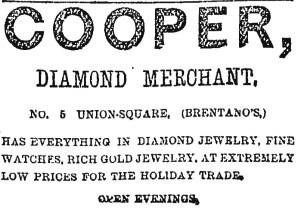 click for larger image
click for larger imageThere are very good maps on Manhattan in the 1880s, but sometimes information on the map itself isn’t enough. I needed to know about a bookstore on Union Square, and I found that info in a newspaper ad.
When historical, real life people wander into something I’m writing, it gets serious.
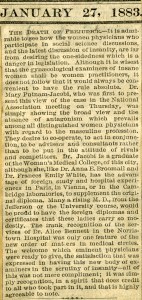 click for larger image
click for larger imageFor example, I have done a lot of research on two people who practiced medicine in Manhattan in the 1880s. Dr. Mary Putnam Jacobi and Dr. Abraham Jacobi, a married couple, both well known to historians of medicine. They both appear now and then in The Gilded Hour, and a little more often in Where the Light Enters, and I have done family trees for them both. Mary interests me because she was the first female physician to challenge the idea that a woman must be maternal first, even in her role as a doctor. The newspaper editorial you see here helped me flesh out her character.
You’re wondering why I would need to do genealogical research on the Jacobis, right?
I know from biographies that they had a son who died as a child. The idea that I would have either of them popping into my storyline to participate in a light-hearted meal with friends on or near the day their son died? Nope. Can’t take that chance. Thus the need to research their lives. I blame my training in the social sciences. I just can’t leave that kind of thing to chance.
I often run across incredibly interesting bits and pieces in the newspapers that make a storyline come to life, and sometimes I post them here, or more likely on Facebook. Here’s one I may put to use at some point:
AIMED AT COURT HARPIES.
Lawyers ask for an Italian speaking-officer In the Tombs Police Court.
Lawyers who practice in the Court of Special Sessions and the Tombs POlice Court are anxious to have a policeman attached to the Court squad who can speak Italian.
This, they say, has become necessary from the fact that a great many worthess Italians hang around the courts and make a living preying upon their unsophisticated countrymen, making all sorts of promises to influence their cases for a consideration.
John J Delaney recently appointed to the Tombs, has done a good deal towards the abolition of the system but enough of it remains to call for the intervention of the Board. With this object in view a step will be taken within a day or two to lay the matter before the Police Commissioners.
Clipped from
The Evening World, 26 Jun 1890, Thu, Second Edition, Page 1

August 18, 2018
Odd connections in historical fiction: the lottery, Cuba, New Orleans, and Little Birds
It has been a while since I posted here on the weblog. I think of it as a bone pile, a huge mountain of stuff that should be sorted and ordered and made useful, but: no time.
Today I’m using it to record an odd set of coincidences that shouldn’t surprise me, really. Historical fiction research often results in this kind of Frankenstein-ian monster, a creaky breathing thing with real potential but at the same time, offputting.
My friend Jason did some research for me last year in the DC libraries, and in the process he ran across reports about Italian immigrants in 19th century New Orleans being lynched. I’m very interested in the huge pile of docs he put together but I haven’t allowed myself to jump in because I’m trying to get this new novel moving. Little Birds is set in New Mexico territory in 1857, you see, so no excuse to be wandering around New Orleans.
But of course I have to get these two people from New York to New Mexico, and that means (1) early train travel — not as well documented as you would guess, unfortunately; (2) St. Louis in its time as doorway to the west — also not as well documented as I would like (for instance, if you can find a street map — any street map, no matter how rough — of St. Louis ca. 1857, you are the more creative researcher than I); (3) travel by steamboat on the Missouri River from St. Louis to Independence (there is more, but not enough information on this).
It’s the last bit I’ve been working on lately, this morning going through Hiram Martin Chittenden’s 1903 History of Early Steamboat Navigation on the Missouri River (Volumes 1 & 2). As anticipated there were lots of missionaries traveling west (Jesuit, Mormon, etc etc) and the whole Bleeding Kansas business had New Englanders headed for Kansas territory (you thought the Civil War started in 1861 when Beauregard opened fire on Fort Sumter in Charleston?)… but really what I’m looking for are odd bits like this:
It so happened that two St. Louisans, Sam Gaty and a man named Baldwin had recently won a prize of forty thousand dollars in the Havana lottery, and were using it in building a boat […] Captain La Barge made the annual voyage of 1855 in this new boat.
$40,000 in the Havana lottery? That was a huge amount of money at this point. So off I go to look into the Havana lottery and I discover… that I’m back in New Orleans, where the Cuban lottery was very, very popular. In fact, all lotteries were so popular that they were the primary way of funding all kinds of projects you would expect to be financed by taxes. From a website which is much too short for my tastes:
By the 1810s the number of lotteries began to rise exponentially, making way for an entirely new profession, the lottery broker. Once sponsoring parties had been granted a franchise, the middleman-broker would oversee every aspect, including ticket sales, advertising, and payouts. Many lottery brokers would go on to stellar careers in banking, such as ticket salesman John Thompson, who founded the Chase National Bank (Chase Manhattan) in 1873. Although states began outlawing lotteries in the 1830s, they remained popular throughout the century; believing as much in luck as in the self-made man, Americans continued to buy lottery tickets in the hopes they could obtain something for nothing. Capitalism by Gaslight
So now I’m straddling New Orleans, St. Louis, the Missouri River, and I’m also back in Manhattan and I’ve got this very interesting character giving me the eye. He’s a lottery broker. Originally from Cuba. Or maybe Italy. A brand new copper by the name of Oscar Maroney who likes card games knows him, and can tell some stories. This lottery broker wants a spot in Little Birds, and he’s going to be persistent about it, I can tell.
Meanwhile I’ve got to get these two characters off the train, through St. Louis and onto a steamboat on the Missouri. One of them is wondering about maybe a detour to New Orleans, and he’s over there talking to a good looking young guy who has just starting his apprenticeship as a steamboat captain on the Mississippi. Name of Sam.

March 29, 2018
Software for the Historical Novelist, and Little Birds
I don’t know how I missed this, but now that I’ve found Aeon Timeline 2, I have to share the good news.
Because I write historical fiction I’m always juggling fictional characters and events with what really happened. I have spent hundreds of hours mapping out battles in order to wind my plot lines in and out and around. The battle of New Orleans in the War of 1812 was a major challenge, and it was, in relative terms, straight-forward.
With this timeline software I can have fictional and non-fictional events displayed in ways that help me visualize connections and overlaps (and more important: errors), and I can color code everything so I can tell the difference right away.
Characters are set up one by one and can be assigned to storylines, and that’s just the tip of this iceberg.
Unfortunately the people at Aeon have put up screenshots that are too dark to really appreciate, but here’s one of them.
 click for full size
click for full sizeThe first thing I did was change the color scheme to dark on light.
I would show you a sample of my own timeline, but that would mean giving away information about the next novel (tentatively titled Little Birds) and that would be really dopey of me at this early stage. She said slyly.

March 22, 2018
trees and the wilderness
March 21, 2018
Excerpt: Where the Light Enters
January 1, 1884
Dear Auntie, Dear every one of you,
The Swiss greet each other on New Year’s Eve with this saying: ‘Rutscht gut rein ins neue Jahr!’ If I understand correctly this means ‘I wish you a good slide into the New Year,’ which I suppose makes sense, given the snow and the mountains and the amount of Schnapps consumed during New Year’s Eve celebrations. For some reason no one can explain, pigs are considered good luck at the New Year, and thus this small offering in India ink rather than pink marzipan.
Aunt Quinlan is not, I trust, sliding anywhere, but sitting snug in the parlor wrapped in the blue shawl that brings out the color of her eyes, with the rest of you gathered all around. How we would like to be there with you to wish you good health and happiness in this new year 1884. With all my heart I wish those things for you.
Cap was especially sad to miss Mrs. Lee’s traditional New Year’s Eve turkey dinner. Apparently that particular bird is unknown in the Alps. But do not fear: we are served good food in abundance. Mrs. Fink is not quite so talented as Mrs. Lee, but still we are eating regularly and very well.
All is calm just now, as Cap is napping. Pip is tucked up against Cap’s shoulder with his nose pressed against the pulse point just below the left ear, an attentive little dog with the instincts of a nurse. This means that I have a short while to write without pauses for cross examination.
Do you remember how Cap told us he wouldn’t miss practicing law? As it turns out, he could only make that claim because he knew he would still have me to practice on. Whatever I write, to whomever I am writing, if I don’t send it off to the post before he realizes what I am up to, he insists that I read every sentence to him. His contribution to my letters consists of suggestions for alternate phrasing and, on occasion, challenges to my reasoning, memory or grammar. More than once I have been tempted to throw the ink pot at his head (this seems to be a family tradition, established by Aunt Quinlan shortly before her first marriage when she hit Uncle Ballentyne in the forehead with some kind of pot, if I remember the story correctly). Fortunately Cap always stops just short of inciting me to violence. And then he finds some way to make me laugh.
We might have known that a stay in a sanatorium, no matter how secluded and hemmed in by alpine glaciers, would not put an end to his curiosity. Even the mycobacterium tuberculosis bacillus has not accomplished so much. He is still working his way through the clinic’s medical library and every publication that deals, however peripherally, with diseases of the lung. At this point I believe he knows as much about tuberculosis as I do. Luckily Dr. Zängerle is better informed than I.
If Cap is not strong enough on a given day to hold a book, I am pressed into reading aloud. Even when he can read and write for himself, my assistance is required for interrogation on medical terminology (though that happens less often as his studies progress). This often involves forays into Latin and Greek etymology and anatomical texts and illustrations. His lungs are failing but his mind is as acute as ever.
Your letter dated December 9th arrived this morning, taken down so diligently by Mrs. Lee in her careful script. Today we also had a letter from Conrad about the custody hearing. The news is distressing, to say the least. If only I had something useful to say or contribute beyond the letters I write. Until there is some decision from the court I will assume that things will take a reasonable and just end, and the children will stay on Waverly Place with Anna and Jack, where they belong.
I’m sorry to say that my weekly report on Cap’s condition is also not what I would hope. A few days ago his right lung collapsed. In an otherwise healthy person, a collapsed lung will often right itself in time, with bed rest and breathing exercises. In advanced pulmonary tuberculosis it is quite common, far more critical, and rarely resolved. In Cap’s case the collapse was not fatal because Dr. Zängerle was so quick. With Dr. Messmer’s assistance he inserted a drainage tube between Cap’s ribs and into the pleura, with the end result that his lung did re-inflate. The tube remains in place despite the fact that there are serious complications that could arise from this artificial opening, but as you are aware, medical science is an exercise in constant juggling of risks and benefits.
What all this means, as I think you will know, is that he is not improving. I can admit to you that I never believed that alpine air and fortified nutrition would reverse the damage to his lungs, but I did hope that it would slow the progress of the disease. As it may have done. In any case, I am where I belong, here with him. He will leave me too soon, but until that day I will make the most of every moment.
Cap is stirring. It is a relief when he is able to fall into a deep sleep; for that short time he looks more like the boy I first met when I came to Waverly Place almost twenty years ago. He was so alive, I could never have imagined him like this. Now I must close this letter before he demands that I read it to him.
With all my love and affection your devoted niece, cousin, auntie and friend
Sophie
Post Script: We have had a letter from Margaret, who is in Greece with her boys. Travel does seem to suit her very well. There was also a long letter from Lucy, with news of her latest adventures.
Post Script for Mrs. Lee: The sight of your handwriting on an envelope gives us both such pleasure. Most of all we look forward to the small notes and observations you provide in the margins. It is almost like hearing your voice, which might be the thing I miss most. Please give our love to Mr. Lee and your family.
And for Lia: To answer the question added to the end of Auntie Q’s last letter, yes, the housekeeper’s name really is Hannelore Fink. In German ‘fink’ doesn’t mean the same thing that it does in English.

January 2, 2018
Mark Twain on April Fool’s Day 1885
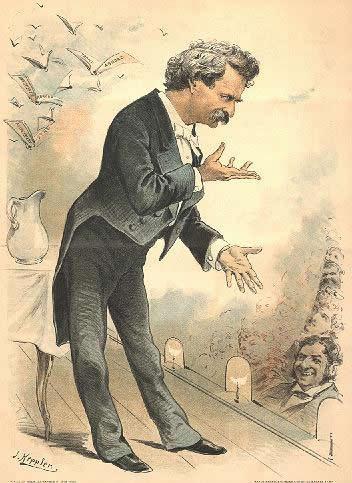 From PUCK. 23 December 1885.
From PUCK. 23 December 1885.I came across a newspaper article today while researching plot notes: MARK TWAIN IN A RAGE. THE VICTIM OF AN APRIL FOOL JOKE.
Pranks were popular in the 19th century, but it’s rare that you come across one described. Certainly not in this kind of detail. I have edited this for length.
It’s not surprising that Mark Twain was a curmudgeon about autographs. I imagine him glaring at anybody so bold as to ask.
Also of possible interest: I often find the best names in this kind of news report. Bloodgood Cutter, for example. I doubt even Rowling could top that one.
APRIL 4, 1884.
MARK TWAIN IN A RAGE. THE VICTIM OF AN APRIL FOOL JOKE.
Special Dispatch to The Times. Hartford, April 3.
Mark Twain, ot this city, has been made the victim of a practical Joke and is fairly crazy. Tuesday morning, April Fools’ Day, he was surprised to receive a bundle of over one hundred letters by mail and later on that day received three hundred more, and up to last night had over a bushel of them scattered on a billiard table table at his home. Every letter asked the humorist for his autograph.
It seems that the Joke originated In the brain of George W. Cable, the novelist. Knowing that the particular abhorrence of Mr. Clemens was the autograph collector and that of all things detestable in this world the great humorist most detested being pestered for his signature, Mr. Cable conceived the Idea of a simultaneous attack on Mark and sent to one hundred and fifty of the [Twain’s] friends a circular requesting each of them to forward to the eminent wit on the 31st of March the most supplicatory request for his autograph they could concoct.
In addition to the communications of T. B. Aldrich and H. C. Bunner letters of a similar sort were forwarded by Richard W. Gilder, of the Century, George Cary Eggleston, Lawrence Hutton, Julian Hawthorne, Robert M. Johnson, James R. Osgood, M. W. Drake and scores of other well-known men of letters. To say that Twain was wild is putting it mildly.
The story was too good to be kept, however, and today It was on the lips of everyone. Some even went so far as to positively affirm that Mr. Clemens had actually challenged Mr. Cable to a duel and also several of the others, but such is not fact. The victim has taken a more cold-blooded view of the matter and now proposes to have a number of the letters published, hoping thereby to bring ridicule on the heads of the Jokers.
SOME SPECIMEN LETTERS.
The following are a few of specimens received.
John Hay writes Irom Cleveland. He wants Mark Twain to take a leisure hour or two and copy for him a few hundred lines of “Young’s Night Thoughts” and an equal amount from Pollock’s ” Course of Time.”
Clara Louise Kellogg sends a dainty note from the Clarendon Hotel, New York, asking for an autograph, and Clara’s mother writes that she is really suffering for one.
Henry Irving sends a typical letter from the Brevoort House, saying; “The possession of an autograph of my dear Mark Twain is a matter of life and death wllh me.
Ellen Terry’s application is brief and to the point. She asks: “Will youn write your name for me?”
Napoleon Sarony writes over the dash of the pen that X X he calls his trademark.
Edmund Clarence Stedman’s letter Is a good burlesque of the average school girl who fills In her spare time in writing to noted people for their autographs. Many of the words are underscored and sugar Mr. Clemens with such sentences as: “My favorite American author” and “your well – known kindness.” Mr. Stedman not only solicits both kinds of Mr. Clemens’ signature, but wants a sentiment in his handwriting or a few pages from “Roughing It,” “The Prince Abroad,” or “The Innocents and the Pauper.”
H. C. Bunner, of Pack, wants an autograph for his two weeks old granddaughter, adding: “The little Innocent abroad in this strange world of ours will value your gift when she is old enough to appreciate it.”
Joe Howard, Jr., recalls meeting meeting Mr. Clemens twenty – four years ago In front of the New York City Hall and then makes an appeal for the autograph.
Thomas W. Knox’s request comes from the Lotos Club. He has a royal commission from the King of Slam for autographs for the King’s two hundred and fifty-eight children. Colonel Knox suggests that the order had better be billed for three hundred, as the King’s family is increasing.
Stephen Fiske wants a Mark Twain autograph for a friend who is going abroad who wishes to take It along as a mascot, and Mrs. Fiske modestly spells the name “Clements” and solicits one hundred and sixty autographs for a church fair booth.
Henry Ward Beecher starts his missive by mentioning that he Is a very curmudgeon about answering autograph letters. Mr. Beecher sends a gilt edged card with a formal demand for an autograph.
R. W. Johnson, of the Century, applies by postal card as follows: “Could you let me have an autograph for a lame boy whose mother has interested him in things spiritual by encouraging him to make an autograph collection to be rallied for at a fair, the proceeds to go to the Society for the Suppression of the Toy Pistol ?”
Bloodgood H. Cutter, the Long Island farmer-poet, makes his request in very poor rhyme.
Frank Jenkins, writing on University Club paper, wants to secure enough Clemens autographs to start out seven daughters as autograph fiends.
Marshal Kinney, of Hartford, wants one at the bottom of a check.


